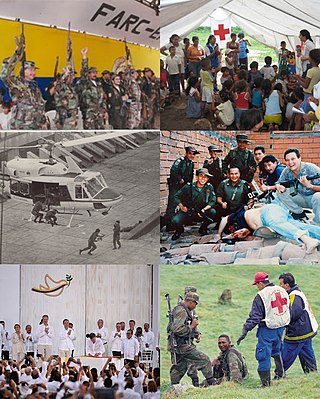热门问题
时间线
聊天
视角
哥伦比亚内战
来自维基百科,自由的百科全书
Remove ads
哥伦比亚内战是在哥伦比亚境内始于1960年代持续至今的一系列低强度不对称战争。冲突在哥伦比亚政府、右翼准军事组织(如哥伦比亚联合自卫军和美洲反共联盟)、贩毒机构(如麦德林集团)还有左翼游击队(如哥伦比亚革命武装力量—人民军、民族解放军和人民解放军)多方之间展开,以在哥伦比亚境内控制更多地区和获得更大影响力[30]。对哥伦比亚内战的国际赞助者包括跨国集团公司、美国[31][32][33]古巴[34]以及贩毒集团[35]。
此条目可参照英语维基百科相应条目来扩充。 (2022年4月21日) |
Remove ads
现代
冷战后,由于失去苏联及其它前社会主义国家的支援,哥伦比亚革命武装力量因要筹集经费,开始插足可卡因及绑架政客等勾当,以致形象急剧转差,被视为恐怖主义组织。[36] 因此,哥伦比亚共产党解除了哥伦比亚革命武装力量与其之间的隶属关系,哥伦比亚革命武装力量遂成为一个独立的政治军事组织。2007年,哥伦比亚革命武装力量人数约为3000-4000人。哥革武参与了哥伦比亚25-30%恐怖事件,尤其是在该国东南部的丛林以及安第斯山脉脚下的平原地区。哥伦比亚革命武装力量曾释放多名“有价值”人质,意图改善形象。
2012年,在以古巴和挪威作为担保国、以委内瑞拉和智利作为观察国的斡旋框架下,双方开始在古巴首都哈瓦那进行和谈。2016年6月23日,双方签署最终停火协议,8月24日哥伦比亚政府与哥伦比亚革命武装力量在古巴首都哈瓦那达成最终全面和平协议,协议包括停战、农村改革、打击贩毒、被遣散的游击队员可参与政治、建立过渡性司法机构等内容,但和平协议内容的合法性最终将由全民公投决定。[37][38]但哥伦比亚前总统乌里韦认为,最初的和平协议向反政府武装妥协过多、对受害者不公,呼吁民众投反对票,并要求对协议进行深入修改。与先前民调结果大相径庭,10月2日举行的公投结果为支持 49.77%,反对 50.22%,协议意外遭到否决。[39]11月24日哥伦比亚总统胡安·曼努埃尔·桑托斯与哥伦比亚革命武装力量领导人罗德里格·隆多尼奥在波哥大的科隆剧院签署了一份经修改的新的和平协议。而这一次,新的协议将会在国会核准,无需再进行全民表决[40]。2017年6月27日,哥伦比亚革命武装力量停止作为武装团体存在。9月1日,该组织正式改组为大众革命替代力量,并于10月31日向官方注册为合法政党。
Remove ads
另见
参考资料
- ^ Why did the Colombia Peace Process Fail? (PDF). The Tabula Rasa Institute. [2006-02-26]. (原始内容 (PDF)存档于2012-07-21). [PDF file]
- ^ Livingstone, Grace. Inside Colombia: Drugs, Democracy, and War. Rutgers University Press. 2004: 176. ISBN 0-8135-3443-7.
- ^ Molano, Alfredo. James Graham (Translator) , 编. Loyal Soldiers in the Cocaine Kingdom: Tales of Drugs, Mules, and Gunmen. Columbia University Press. 2004-02-18. ISBN 0-231-12915-7.
- ^ Peter, Canby. Latin America's longest war; "More Terrible than Death: Massacres, Drugs, and America's War in Colombia," "Walking Ghosts: Murder and Guerrilla Politics in Colombia," "Inside Colombia: Drugs, Democracy and War," "Loyal Soldiers in the Cocaine Kingdom: Tales of Drugs, Mules and Gunmen," "Law in a Lawless Land: Diary of a Limpieza in Colombia"; Book Review. The Nation. 2004-08-16, 279 (5): 31 [2017-05-05]. (原始内容存档于2006-10-20).
- ^ Stokes, Doug. America's Other War: Terrorizing Colombia. Canadian Dimension. 2005-07-01, 39 (4): 26 [2017-05-05]. (原始内容存档于2016-01-09).
- ^ Stokes, p. 26, quoting Marc Grossman, U.S. undersecretary of state for political affairs.
- ^ Dudley, Steven; January. Walking Ghosts: Murder and Guerrilla Politics in Colombia. Routledge. 2004. ISBN 0-415-93303-X.
- ^ Corbyn, Jeremy. Supporting terror; Jeremy Corbyn MP explains the reasons why Britain should be staying well clear of Colombian President Uribe Velez's regime. Morning Star. 2003-07-02: 7 [2017-05-05]. (原始内容存档于2006-05-31).
- ^ Livingstone, (Foreword by Pearce, Jenny), p. xvii (f24)
- ^ Livingstone, p. 5;
Pearce, Jenny. 1st , 编. Colombia:Inside the Labyrinth. London: Latin America Bureau. 1990-05-01: 287. ISBN 0-906156-44-0. - ^ Pearce's forward in Livingstone, p. xx
- ^ LeGrand, Catherine C. The Colombian crisis in historical perspective (Record in progress). Canadian Journal of Latin American & Caribbean Studies. June 2003, 28 (55/5): 165–209 [2017-05-05]. (原始内容存档于2006-05-31).
- ^ Economic Indicators Real Sector, 1999–2004. Latin Focus. [2006-05-31]. (原始内容存档于2006-06-19).
- ^ Legrand, p. 165. See Note #15 for more on women in the conflict.
- ^ Legrand, p. 165. See Note #18 for more on peasant support for the guerrillas. (see also Ortiz 2001; Reyes Posada and A. Bejarano 1988; Archila N. 1996)", Notes.
- ^ Legrand, p. 165. Lengrand states: "Some observers noted that this percentage of supposed paramilitary supporters elected to congress in March 2002 corresponded to the number of representatives elected from Uraba and the Atlantic coast where the paramilitaries are strong. (El Tiempo March 13–14, 2002)", see Notes.
- ^ Colombia’s Three Wars: U.S. Strategy at the Crossroads (PDF). Strategic Studies Institute of the U.S. Army War College. [2006-02-26]. (原始内容存档 (PDF)于2018-06-29). [PDF file]
- ^ Colombia’s Three Wars: U.S. Strategy at the Crossroads (PDF). Strategic Studies Institute of the U.S. Army War College. [2006-02-26]. (原始内容存档 (PDF)于2018-06-29). [PDF file]
James, Preston Everett. Latin America (4th edition). The Odyssey Press. 1969: 426. - ^ The United States and Colombia: The Journey from Ambiguity to Strategic Clarity (PDF). Strategic Studies Institute of the U.S. Army War College. [2006-02-26]. (原始内容存档 (PDF)于2018-05-29). [PDF file]
- ^ Livingstone, p. 5; Author Unknown. Bergquist, Charles , 编. Violence in Colombia, 1990–2000: Waging War and Negotiating Peace. SR Books. February 2001: 13. ISBN 0-8420-2869-2.
- ^ Livingstone, p. 110.
- ^ Livingstone, p. 7; Quoting: Colombia: Inseguridad, Violencia, y Desempeño Económico en las Areas Rurales, Consejería para la Paz de la Presidencia de la República, Colombia, 1999, Director de Investigación: Jesus Antonio Bejarano Avila.
- ^ Livingstone, p. 5
- ^ Livingstone, p. 5; Canby, p 31
Colombia. infoplease.com. [2006-02-26]. (原始内容存档于2013-05-17). - ^ Livingstone, p. 6; Amnistía Internacional Colombia Seguridad, ¿a qué precio? La falta de voluntad del gobierno para hacer frente a la crisis de derechos humanos. Amnesty Internacional (Amnesty International). December 2002 [2017-05-05]. (原始内容存档于2007-11-07).
- ^ Livingstone, p. 6; Source: Colombian Commission of Jurists; Arocha, Jaime. Evolución reciente del conflicto armado en Colombia: La Guerrilla in Las violencias: inclusión creciente 1998. Bogata: CES. 1998: 35–65. ISBN 958-96259-5-9.
- ^ Livingstone, p. 6; Source: Colombian Commission of Jurists; Author Unknown. Country report on Human Rights in Colombia. US State Department. 2000: 1 (mimeograph).
- ^ Livingstone, p. 7; Source: Departamento Administrativo de Seguridad (DAS); Richani, Nazih. Systems of Violence: The Political Economy of War and Peace in Colombia. State University of New York Press. 2002-04-01. ISBN 0-7914-5345-6.
- ^ Livingstone, p. 7; Richani, p. 87
- ^ Livingstone, p. 7
Remove ads
外部链接
Wikiwand - on
Seamless Wikipedia browsing. On steroids.
Remove ads

